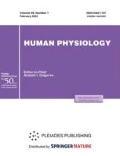Abstract
Systemic assessments of the efficiency of human night sleep, made on a large number of healthy people, as well as the data on modeling the structure of their sleep using Pareto’s principle, are presented. In contrast to the assessment of the efficiency of sleep as the ratio of the duration of electrophysiological sleep to the total time of sleep, our method increases the adequacy of assessment by taking into account the gender factor in somnology and personalized medicine.
Similar content being viewed by others
References
Rechtschaffen, A. and Kales, A., A Manual of Standardized Terminology, Techniques and Scoring System for Sleep Stage of Human Subjects, Los Angeles: Brain Information Service/Brain Research Institute, UCLA, 1968.
The AASM Manual 2007 for the Scoring of Sleep and Associated Events: Rules, Terminology and Technical Specifications, Westchester: American Academy of Sleep Medicine, 2007.
Chokroverty, S., An overview of normal sleep, in Sleep Disorders Medicine: Basic Science, Technical Considerations and Clinical Aspects, Chokroverty, S., Ed., Philadelphia: Elsevier, Butterworth, 2009, 3rd edition, p. 3.
Atlas of Clinic Sleep Medicine, Kryger, M.H., Ed., Philadelphia: Saunders, 2010.
Kovrov, G.V. and Posokhov, S.I., RF patent 2144310, applied in 1997, published in 2000.
Grachev, G.A., Modelirovanie printsipa Pareto (Modeling Pareto Principle), Rostov-on-Don: YuFU, 2011.
Redline, S., Kirchner, H.L., Quan, S.F., Gottlieb, D.J., Kapur, V., and Newman, A., The effects of age, sex, ethnicity, and sleep-disordered breathing on sleep architecture, Arch. Intern. Med., 2004, vol. 164, p. 406.
Hudson, D.J., Statistics for Physicists. CERN Report (unpublished). Geneva, 1964.
Sysoeva, Yu.Yu. and Verbitsky, E.V., Individual cyclic variations in the brain Δ rhythm during slow-wave sleep in humans, Dokl. Biol. Sci., 2012, vol. 444, no. 1, p. 137.
Verbitsky, E.V., Anxiety and sleep, Zh. Vyssh. Nervn. Deyat. im. I.P. Pavlova, 2013, vol. 63, no. 1, p. 6.
Author information
Authors and Affiliations
Additional information
Original Russian Text © E.V. Verbitsky, G.A. Grachev, 2013, published in Fiziologiya Cheloveka, 2013, Vol. 39, No. 6, pp. 115–119.
Rights and permissions
About this article
Cite this article
Verbitsky, E.V., Grachev, G.A. Analysis of the efficiency of human sleep according to Pareto’s principle. Hum Physiol 39, 663–666 (2013). https://doi.org/10.1134/S0362119713060121
Received:
Published:
Issue Date:
DOI: https://doi.org/10.1134/S0362119713060121




